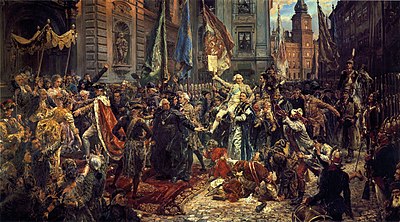
Back دستور الثالث من مايو عام 1791 Arabic Канстытуцыя 3 мая 1791 года Byelorussian Канстытуцыя 3 траўня 1791 году BE-X-OLD Конституция на Жечпосполита Bulgarian Constitució de Maig de Polònia Catalan Ústava z 3. května 1791 Czech Verfassung vom 3. Mai 1791 German Σύνταγμα της 3ης Μαΐου 1791 Greek Konstitucio de la 3-a de Majo Esperanto Constitución del 3 de mayo Spanish
| Government Act | |
|---|---|
 First page of original manuscript of Constitution of 3 May 1791, registered (upper right corner) on 5 May 1791 | |
| Created | 6 October 1788 – 3 May 1791 |
| Ratified | 3 May 1791 |
| Location | Central Archives of Historical Records, Warsaw |
| Author(s) | |
| Full text | |

The Constitution of 3 May 1791,[1][a] titled the Government Act,[b] was a written constitution for the Polish–Lithuanian Commonwealth adopted by the Great Sejm that met between 1788 and 1792. The Commonwealth was a dual monarchy comprising the Crown of the Kingdom of Poland and the Grand Duchy of Lithuania; the new constitution was intended to address political issues following a period of political agitation and gradual reform that began with the Convocation Sejm of 1764 and the election that year of Stanisław August Poniatowski, the Commonwealth's last king. It is the third written constitution in history, after that of the United States and San Marino.
The Constitution sought to implement a more effective constitutional monarchy, introduced political equality between townspeople and nobility, and placed the peasants under the government's protection, mitigating the worst abuses of serfdom. It banned pernicious parliamentary institutions such as the liberum veto, which had put the Sejm at the mercy of any single deputy, who could veto and thus undo all the legislation adopted by that Sejm. The Commonwealth's neighbours reacted with hostility to the adoption of the Constitution. King Frederick William II of Prussia broke the Prussian alliance with the Commonwealth, joining with Imperial Russia under Catherine the Great and the anti-reform Targowica Confederation made up of Polish magnates to defeat the Commonwealth in the Polish–Russian War of 1792.
The 1791 Constitution was in force for less than 19 months.[2][3] It was declared null and void by the Grodno Sejm that met in 1793,[1][3] though the Sejm's legal power to do so was questionable.[3] The Second and Third Partitions of Poland (1793, 1795) ultimately ended Poland's sovereign existence until the close of World War I in 1918. Over those 123 years, the 1791 Constitution helped keep alive Polish aspirations for the eventual restoration of the country's sovereignty. In the words of two of its principal authors, Ignacy Potocki and Hugo Kołłątaj, the 1791 Constitution was "the last will and testament of the expiring Homeland".
- ^ a b Cite error: The named reference
Davies1992was invoked but never defined (see the help page). - ^ Cite error: The named reference
Machnikowski2010was invoked but never defined (see the help page). - ^ a b c Cite error: The named reference
Ligeza2017was invoked but never defined (see the help page).
Cite error: There are <ref group=lower-alpha> tags or {{efn}} templates on this page, but the references will not show without a {{reflist|group=lower-alpha}} template or {{notelist}} template (see the help page).
© MMXXIII Rich X Search. We shall prevail. All rights reserved. Rich X Search